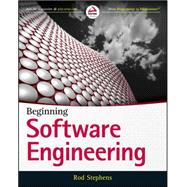A complete introduction to building robust and reliable software
Beginning Software Engineering demystifies the software engineering methodologies and techniques that professional developers use to design and build robust, efficient, and consistently reliable software. Free of jargon and assuming no previous programming, development, or management experience, this accessible guide explains important concepts and techniques that can be applied to any programming language. Each chapter ends with exercises that let you test your understanding and help you elaborate on the chapter's main concepts. Everything you need to understand waterfall, Sashimi, agile, RAD, Scrum, Kanban, Extreme Programming, and many other development models is inside!
- Describes in plain English what software engineering is
- Explains the roles and responsibilities of team members working on a software engineering project
- Outlines key phases that any software engineering effort must handle to produce applications that are powerful and dependable
- Details the most popular software development methodologies and explains the different ways they handle critical development tasks
- Incorporates exercises that expand upon each chapter's main ideas
- Includes an extensive glossary of software engineering terms








